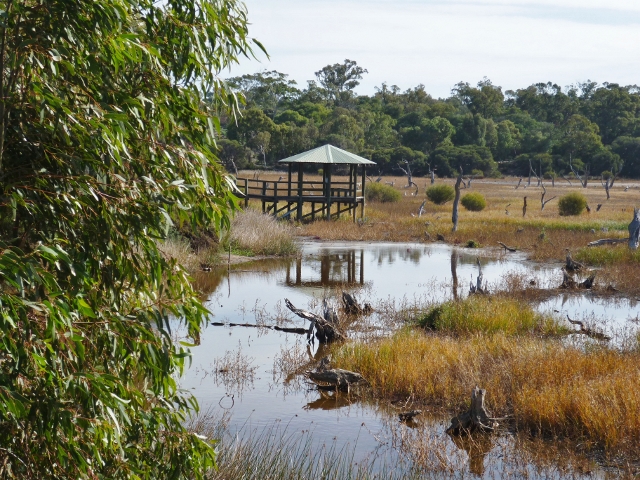A wetland is land that is covered or saturated with water, for part of the year or permanently. Some wetlands are linked to the groundwater with their depth rising or falling to reflect the aquifer levels.
Other areas collect water only after direct heavy or sustained rainfall and/or when a linking stream or other water channel fills them. They can be known by many other names including ponds, marshes, mudflats, lakes and rivers.
Wetlands environment
Wetlands host a large diversity of fauna and flora species, and many have evolved to rely on the resources that only a wetland can provide. Many migratory birds are reliant on the appearance of wetlands after rain to provide food and water during their journeys. Some frogs burrow deep into the moist soil, entering a low-energy state similar to hibernation, where will stay during dry summers and times of drought, emerging when rains soften the ground enough for them to dig their way out. A wetland’s capacity to hold large amounts of water is also invaluable for helping to prevent flooding during heavy rains.
Improving water quality
Wetlands do a lot of work when it comes to improving water quality by filtering out nutrients and pollutants. These elements leech into our waterways from fertilisers, fuel, human antibiotics, and other waste materials. When these pollutant levels are too high it can cause eutrophication – the increased growth of algae – which cuts off light and deoxygenates the water resulting in the deaths of aquatic plants and fish essential for a healthy eco-system. The cleansing filtration is done by wetland soils, plants and agitation, and helps to reduce these elements reaching larger water bodies such as rivers or the ocean.
Humans and water
The importance of wetlands to humans should not be underestimated either. Throughout our history they have been critical for drinking water and food sources and remain so today.
They are often of historic cultural significance and even today provide a meeting place for recreational activities or simply the opportunity to connect with water, which many people find soothing and beneficial for their mental health.
With the increase in hard surfaces, brick and concrete buildings and human infrastructure, metropolitan wetlands also provide a reprieve from the urban heat.
Wetlands need support
With increased population and urban sprawl, many wetlands have been filled in, drained, or modified and relegated to unimportant aspects of the landscape. With an increased understanding of their importance, there is a push to improve existing wetland habitats and re-establish other areas that have been neglected.
The Swan Canning River Recovery Program
Perth NRM’s environment team supports community action that improves the integrity of the Swan and Canning River systems. The main focus is eradicating the Water Pennywort (Hydrocotyle) plant and other weed management, and other actions to improve the ‘Middle Canning’ section of river (from Booragoon to Cannington), its connecting smaller rivers and streams (tributaries) and associated wetlands.
One such project is the adaption of an existing open drain into a ‘living stream’ and the installation of a constructed wetland at Nurdi Park in Riverton. Click here to read more about this project.
What you can do
To protect and improve the sustainability of wetlands, here are some simple steps for your home and business:
- Reduce the use of fertilisers: these additives leach into groundwater and drains, ending up in the lakes, rivers and oceans and increasing the risk of algae blooms. Instead, improve your soil using compost, mulch and planting hardy local native species – this will reduce your water bills and reliance on fertilisers. Check out the ReWild Perth project to learn more.
- Prevent sands, soils, leaves or any debris from entering street drains, as they flow directly into our wetlands and rivers.
- Dispose of waste materials thoughtfully: household liquids and materials should be separated, recycled where appropriate, and disposed of appropriately. For example: medications and supplement tablets can be returned to a chemist for safe disposal; cooking oil can be reused and then poured into alfoil for rubbish disposal instead of being tipped down the sink.
- Don’t throw your aquariums (and fish) into the river system! Introduced fish and aquarium plants are a major threat to our wetlands and rivers – weed species such as Hydrocotyle have taken decades to manage.
- Support wetland rehabilitation – follow us on Facebook and Instagram and subscribe to our newsletter to learn about upcoming planting days.
This project is supported by Perth NRM through funding from the Australian Government.
Image: Lake Claremont, by Gary Tate.
References:
https://oceanservice.noaa.gov/facts/wetland.html
https://backyardbuddies.org.au/backyard-buddies/burrowing-frogs/
https://www.lfwseq.org.au/frogs-go-winter/
https://oceanservice.noaa.gov/facts/eutrophication.html
Partners
We acknowledge and appreciate the support of all our partners, supporters, funding bodies and sponsors.


